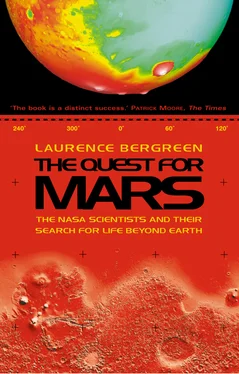The message in a bottle had arrived, but who would decipher it correctly?
Throughout the summer of 1996, David McKay expected a backlash concerning his discovery, but it was slow in coming. At first, members of the public, some of them deeply suspicious of all federal agencies, NASA included, sent him angry e-mails, most of which echoed the theme, “What kind of fools do you take us for?” One said, “Your life on Mars story is a good example of your mistaken belief that the general public is comprised of a bunch of total idiots.”
Eventually, scientists joined the clamor. Some insisted that ALH 84001 proved absolutely nothing. The wormlike structures, said critics, were far too small to be bacteria; in fact, they were many times smaller than the smallest bacteria ever seen on Earth. Others insisted that if the meteorite contained evidence of biological activity, it was the result of contamination. Still others challenged the team’s analysis of the PAHs. Some scientists stated flatly that McKay and his team had unfairly manipulated the evidence to support a flawed hypothesis. Everett Shock at Washington University invoked the Murchison meteorite, believed to have come from the asteroid belt, to invalidate the discovery. “It has carbonate minerals in it,” he said, “and real solid evidence of water – yet there isn’t anybody saying that there is life in the asteroid belt.” True, no one was saying it at the time, but that situation is beginning to change as scientists have come to think of life as widely distributed throughout the Solar System. Finally, the scientists attacked the reputations of McKay and his team, a tactic that took cooler heads by surprise. “It’s kind of strange when scientists, who are thought to be rational, become emotional,” said Marilyn Lindstrom, a curator of meteorites at the Johnson Space Center. “What bothers me most is that so many people have made up their minds before the data come in. I mean, sometimes I’m amazed by McKay and Gibson’s almost true-believer attitude.”
Carl Sagan was seriously ill at the time of the announcement, with only a few months to live. During his decades with NASA, he had become familiar with both the science and the passions involved in the search for life beyond Earth, and his pronouncement on the subject was enlightening yet equivocal. “For years I’ve been stressing with regard to UFOs that extraordinary claims require extraordinary evidence. The evidence for life on Mars is not yet extraordinary enough. But it’s a start.” Although he was deeply intrigued by the meteorite team’s findings, Sagan insisted that more study was required. Yet other scientists were convinced by McKay’s rigorous approach. “If this is not biology,” said Joseph Kirschvink of Caltech, “I am at a loss to explain what the hell is going on. I don’t know of anything else that can make crystals like that.”
Because McKay, Gibson, and company were cautious, even cunning, in the way they stated their findings, they made it difficult for their critics to disprove their argument. The meteorite team held that the fossils were merely possible evidence of relic life; they were not the only explanation for what they’d found, merely the best explanation. To disprove or dismiss these findings, their critics would have to understand ALH 84001 even better than the original investigators did. They would have to refute four separate, interrelated lines of argument. They would have to be familiar with geochemistry and physics and geology and of course biology. No one person knew enough about all these fields as they applied to the meteorite; it would take a team, a bigger and better team, to show McKay and his colleagues the error of their ways.
The significance of the debate transcended the meteorite itself. Even if it contained crystals that mimicked biological morphology, or contamination, the search for extraterrestrial life had undergone a sea change. Even scientists who thought ALH 84001 contained no life signs at all now found themselves thinking that if we were going to find evidence of extraterrestrial life, it would probably be tiny and ancient and carried throughout the Solar System in a meteorite. McKay, Gibson, and Thomas-Keprta’s real discovery was a new paradigm . Even if their conclusions turned out to be incorrect, their thinking was too sophisticated to dismiss. From now on, they would define the terms in the search for extraterrestrial life. Their credibility rested not so much on what they found as on how they found it: their precise, rigorous methodology.
Two years after the announcement, I found Kathie Thomas-Keprta in the featureless Building 31 at the Johnson Space Center, where many of the crucial discoveries concerning the meteorite had occurred. She is tall and slender, with long blond hair swept up in back. Despite the intense debate concerning her work, she didn’t look embattled; she was poised, with a certain swagger and the smooth delivery of a television talk show host, at least in one-on-one conversation. We were standing beside another Martian meteorite, EETA 79001, a cousin of the more famous ALH 84001. EETA 79001 resembles a black ice cube, about two inches by two inches. I peered carefully at this Martian specimen. There wasn’t much to see except for a little hole in one side drilled by a laser to extract gases trapped within.
Her team expected a lot of debate after their discovery, she told me, although the vehemence came as a surprise. “Still, all the criticism and attacks on our findings don’t bother me because I’m from Green Bay Wisconsin, and I’ve been a Packers fan for thirty years, and I know what it’s like to hang in there from one losing season to the next.” She thought it would take five to ten years for their findings to be fully vindicated, and she couldn’t wait for that day. Her case now was stronger than ever, she said. The recent discovery of microorganisms far below the Columbia River, in Washington State, gave her a lot of corroborating evidence for nano-life on Mars. No one expected to find nanobacteria a mile or more below the surface of the Earth, and no one knows how they started growing. Like their ancient Martian cousins, they live in basalt. More important, they are almost as small as the Martian nanofossils. Critics of the meteorite team insisted that the presumed nanofossils in ALH 84001 were much smaller than any organisms found on Earth – too small to be considered micro-organisms. Since the Columbia River discovery, that objection lost much of its force.
I wondered what kind of energy source for life could be found in rock a mile or two underground, where there is no sunlight, no lightning, no real heat from the Earth’s core. Some scientists think the source could be as simple as water passing over the basalt, which might cause a chemical reaction. If this is the case, the answer to the Genesis Question becomes simpler all the time; it appears that the rock bottom (so it might be said) requirements for life are even more minimal than scientists believed only a few years earlier. All you need is water and an energy source for life to emerge. Water might be running through subsurface basalt everywhere; the same thing might have happened on other planets, or even on asteroids; it might be happening now . There might be more ways for life to emerge than we now imagine – enough to suggest that life really is an inevitable outcome of chemistry and an inevitable part of the universe, predestined, as it were, but so simple that we hardly acknowledge the phenomenon for what it is.
David McKay is tall, slender, silver-haired, professorial, imposing. As the leader of the meteorite team, he is suspicious of outsiders and chooses his words with care. His office, where we met, is capacious, even by the standards of the sprawling Johnson Space Center, and the walls are lined to the ceiling with plaques, awards, degrees, citations, and a child’s squiggly drawing of a small Martian meteorite beside a large man labeled, “Dad.”
Читать дальше












